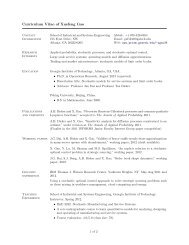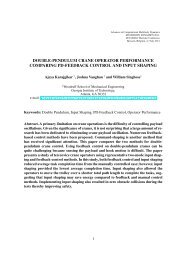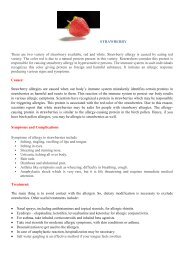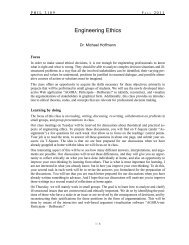paper - ACM Digital Library
paper - ACM Digital Library
paper - ACM Digital Library
Create successful ePaper yourself
Turn your PDF publications into a flip-book with our unique Google optimized e-Paper software.
SIMD Re-Convergence At Thread Frontiers<br />
Gregory Diamos Benjamin Ashbaugh<br />
Georgia Institute of<br />
Intel<br />
Technology<br />
Visual Computing Group<br />
School of ECE<br />
Folsom, CA<br />
Atlanta, GA, USA bashbaugh@intel.com<br />
gregory.diamos@gatech.edu<br />
Subramaniam Maiyuran<br />
Intel<br />
Visual Computing Group<br />
Folsom, CA<br />
subramaniam.maiyuran@intel.com<br />
Andrew Kerr<br />
Georgia Institute of<br />
Technology<br />
School of ECE<br />
Atlanta, GA, USA<br />
arkerr@gatech.edu<br />
Haicheng Wu<br />
Georgia Institute of<br />
Technology<br />
School of ECE<br />
Atlanta, GA, USA<br />
hwu36@gatech.edu<br />
Sudhakar Yalamanchili<br />
Georgia Institute of<br />
Technology<br />
School of ECE<br />
Atlanta, GA, USA<br />
sudha@ece.gatech.edu<br />
ABSTRACT<br />
Hardware and compiler techniques for mapping data-parallel<br />
programs with divergent control flow to SIMD architectures<br />
have recently enabled the emergence of new GPGPU programming<br />
models such as CUDA, OpenCL, and DirectX<br />
Compute. The impact of branch divergence can be quite different<br />
depending upon whether the program’s control flow<br />
is structured or unstructured. In this <strong>paper</strong>, we show that<br />
unstructured control flow occurs frequently in applications<br />
and can lead to significant code expansion when executed<br />
using existing approaches for handling branch divergence.<br />
This <strong>paper</strong> proposes a new technique for automatically<br />
mapping arbitrary control flow onto SIMD processors that<br />
relies on a concept of a Thread Frontier, which is a bounded<br />
region of the program containing all threads that have branched<br />
away from the current warp. This technique is evaluated<br />
on a GPU emulator configured to model i) a commodity<br />
GPU (Intel Sandybridge), and ii) custom hardware support<br />
not realized in current GPU architectures. It is shown that<br />
this new technique performs identically to the best existing<br />
method for structured control flow, and re-converges at<br />
the earliest possible point when executing unstructured control<br />
flow. This leads to i) between 1.5 − 633.2% reductions<br />
in dynamic instruction counts for several real applications,<br />
ii) simplification of the compilation process, and iii) ability<br />
to efficiently add high level unstructured programming constructs<br />
(e.g., exceptions) to existing data-parallel languages.<br />
Categories and Subject Descriptors<br />
D.3.4 [Software]: Programming Languages—processors, compilers;<br />
C.1.2[Computer Systems Organization]: Processor<br />
Architectures—multiple data stream architectures<br />
Permission to make digital or hard copies of all or part of this work for<br />
personal or classroom use is granted without fee provided that copies are<br />
not made or distributed for profit or commercial advantage and that copies<br />
bear this notice and the full citation on the first page. To copy otherwise, to<br />
republish, to post on servers or to redistribute to lists, requires prior specific<br />
permission and/or a fee.<br />
MICRO’11, December 3-7, 2011, Porto Alegre, Brazil.<br />
Copyright 2011 <strong>ACM</strong> 978-1-4503-1053-6/11/12 ...$10.00.<br />
General Terms<br />
Design, Experimentation, Performance<br />
1. INTRODUCTION<br />
The transition to many core computing has coincided with<br />
the growth of data parallel computation and the evolution of<br />
graphics processing units (GPUs) from special purpose devices<br />
to programmable cores. The emergence of low cost programmable<br />
GPU computing substrates from NVIDIA, Intel,<br />
and AMD have made data parallel architectures a commodity<br />
from embedded systems through large scale clusters such<br />
as the Tsubame [1] and Keeneland systems [2] hosting thousands<br />
of GPU chips.<br />
The dominant programming model involves the use of<br />
bulk-synchronous-parallel computing models [3] embodied<br />
by languages such as CUDA, OpenCL, and DirectX Compute.<br />
These data-parallel languages implement single instruction<br />
stream multiple thread (SIMT) models of computation<br />
that specify a large number of data-parallel threads<br />
that can be readily exploited by hardware multi-threading<br />
and single-instruction-multiple-data (SIMD) cores. Modern<br />
GPU architectures have demonstrated support for efficient,<br />
automatic mappings of arbitrary control flow onto<br />
SIMD processors, and in fact these languages rely on it to<br />
retain many of the control flow abstractions found in modern<br />
high level languages and simplify the task of programming<br />
SIMD processors. Performance is maximized when all<br />
of the threads mapped to the same SIMD unit (henceforth<br />
warp) take the same path through the program. However,<br />
when threads in a warp do diverge on a branch, i.e., different<br />
threads take different paths, performance suffers. This<br />
is referred to as branch divergence and its behavior is critical<br />
to SIMD processor performance.<br />
Previous work by Wu et al. [4], assessed the impact of<br />
unstructured control flow in existing applications and commonly<br />
used benchmarks. They found that unstructured control<br />
flow occurs quite often (in 40% of the Parboil, Rodinia<br />
and Optix benchmarks) in applications and is either introduced<br />
by the programmers (e.g. using goto statements) or<br />
by the compiler optimizations (e.g., function inlining, shortcircuit,<br />
etc). Usually, the more complex the program, the<br />
477
more likely the existence of unstructured control flow. They<br />
investigated techniques for converting unstructured control<br />
flow to structured control flow and found that these techniques<br />
can substantially increase static and dynamic code<br />
size. Further, the analysis reported in this <strong>paper</strong> found that<br />
the dynamic code expansion in the presence of unstructured<br />
control flow (with no transformation) could be substantial<br />
(see Section 6). Finally, we note that several desirable language<br />
features (e.g., exceptions) naturally lead to unstructured<br />
control flow. We show that this commonly leads to<br />
performance degradation, even if exceptions are not encountered<br />
at runtime. Consequently, we argue that support for<br />
unstructured control flow is justified by its frequency of occurrence,<br />
performance impact, and the functionality it enables.<br />
This <strong>paper</strong> proposes a novel scheme - thread frontiers -<br />
to address branch divergence in SIMD processors. For each<br />
basic block, the thread frontier of that block is informally<br />
defined as the set of other basic blocks where all other diverged<br />
threads may be executing. At runtime, if a thread<br />
is executing basic block BB, all other threads from the same<br />
warp will be found in the thread frontier of BB. The principle<br />
contribution of thread frontiers is its ability to efficiently<br />
handle unstructured control flow in SIMD processors.<br />
Threads in a warp are permitted to re-converge earlier<br />
than achieved in existing schemes thereby eliminating code<br />
expansion due to branch divergence. Thread frontiers can in<br />
fact be implemented on some modern GPUs. We report on<br />
the performance from modeling this implementation as well<br />
as simulation results of a proposed native implementation.<br />
Our evaluation has considered 8 existing highly tuned applications<br />
and 5 microkernels representing (desirable) language<br />
features not typically supported in GPUs . Specifically, this<br />
<strong>paper</strong> makes the following contributions.<br />
• We show how unstructured control flow causes dynamic<br />
and static code expansion (1.5%-633%) for existing<br />
hardware and compiler schemes for handling control<br />
flow on SIMD processors. We show that this code<br />
expansion can severely degrade performance in cases<br />
that do occur in real applications.<br />
• To handle unstructured control flow effectively, we introduce<br />
a new concept of a thread frontier that can<br />
be used conservatively by a compiler or optimistically<br />
with hardware support to identify the earliest re-converge<br />
point of any divergent branch, thereby avoiding any<br />
code expansion when executing programs with unstructured<br />
control flow.<br />
• We describe how thread frontiers can be implemented<br />
using existing hardware on a modern GPU - Intel Sandybridge<br />
- and provide an empirical evaluation of performance<br />
using a Sandybridge emulator.<br />
• We evaluate the performance of thread frontiers using<br />
native hardware support modeled using extensions to<br />
a GPU emulator.<br />
• We show how support for thread frontiers can make<br />
it acceptable, from a performance perspective, to support<br />
language features such as divergent function calls<br />
and exceptions in SIMD processors. These features<br />
produce unstructured control flow.<br />
1.1 Organization<br />
The remainder of the <strong>paper</strong> first introduces existing reconvergence<br />
mechanisms, and then thread frontiers by way<br />
of an illustrative example. The following sections describe<br />
the compiler and hardware support. The <strong>paper</strong> concludes<br />
with a description of the results of the evaluation of a benchmark<br />
suite of CUDA applications with unstructured control<br />
flow, lessons learned and directions for future research.<br />
1.2 Terminology<br />
Terms used to describe GPU abstractions such as dataparallel<br />
threads and groups of threads that are mapped to<br />
a SIMD unit vary in the literature depending on the specific<br />
GPU being considered. The NVIDIA terminology is<br />
adopted in this <strong>paper</strong> to maintain consistency with related<br />
work. A warp refers to the threads executing on a SIMD<br />
processor - one thread per SIMD lane. When reading Intel<br />
documentation, it is necessary to use the term channel to refer<br />
to an NVIDIA thread, andthread to refer to an NVIDIA<br />
warp. This means that the per-thread program counters<br />
(PTPCs) used in this <strong>paper</strong> are referred to as per-channel<br />
instruction pointers (PCIPs) by Intel.<br />
2. RE-CONVERGENCE MECHANISMS<br />
2.1 Predicate Stack<br />
In 1982 the CHAP [5] graphics processor introduced the<br />
concept of a stack of predicate registers combined with explicit<br />
if-else-endif and do-while instructions to transparently<br />
enable the execution of structured control flow on<br />
a SIMD processor. In their work concerning dynamic warp<br />
formation, Fung et al [6] also describe a technique that<br />
they refer to as immediate post-dominator re-convergence<br />
(PDOM), which extends the concept of a predicate stack to<br />
support programs with arbitrary control flow using branch<br />
and re-converge instructions. This is done by finding the<br />
immediate post-dominator for all potentially divergent branches<br />
and inserting explicit re-converge instructions. When a divergent<br />
branch is executed, a predicate mask and PC is computed<br />
for each unique branch target and pushed onto a stack.<br />
Execution continues using the top entry on the stack, and<br />
the stack is popped when a re-converge point is hit. In order<br />
to resume execution after all paths have reached the postdominator,<br />
the program counter of the warp executing the<br />
branch is adjusted to the instruction immediately after the<br />
re-converge point before the first entry is pushed onto the<br />
stack.<br />
2.2 Per-Thread Program Counters (PTPCs)<br />
Although previous generations of Intel GPUs have used<br />
the predicate stack mechanism for control flow, a new mechanism<br />
was introduced starting with the Sandybridge processor.<br />
According to the ISA reference manual [7], the mechanism<br />
changes by removing the predicate stack and instead<br />
introducing a program counter (PC) for each thread along<br />
with the main PC for each warp. When an instruction is<br />
issued the per-thread PC is checked against the warp PC. If<br />
they match, that thread is enabled and its PC is advanced<br />
along with the warp PC. Otherwise, it is disabled and it is<br />
not modified. The warp PC is always modified, either by incrementing<br />
to the next instruction in the basic block or by<br />
updating it according to the outcome of branch instructions.<br />
This is discussed in greater detail in Section 5.<br />
478
if(<br />
(cond1() || cond2())<br />
&&<br />
(cond3() || cond4())<br />
)<br />
{<br />
...<br />
}<br />
<br />
bra cond2()<br />
entry<br />
<br />
bra cond1()<br />
<br />
bra cond3()<br />
<br />
<br />
entry<br />
<br />
<br />
<br />
<br />
<br />
<br />
<br />
<br />
<br />
<br />
<br />
<br />
bra cond4()<br />
<br />
<br />
<br />
<br />
<br />
<br />
<br />
<br />
<br />
<br />
<br />
<br />
<br />
<br />
<br />
T0 T1 T2 T3 Warp PC stack<br />
<br />
BB1 BB1 BB1 BB1 BB1<br />
BB2<br />
BB3<br />
BB4<br />
BB5<br />
BB3 BB3<br />
BB4 BB4<br />
BB2 BB2 BB2<br />
BB3 BB3<br />
BB4<br />
BB5<br />
Push BB3, BB2<br />
Push Exit, BB3<br />
Push BB5, BB4<br />
Pop<br />
Pop<br />
<br />
<br />
<br />
<br />
<br />
T0 T1 T2 T3<br />
<br />
BB1 BB1 BB1 BB1<br />
BB2 BB2 BB2<br />
thread-frontier<br />
BB3<br />
BB4<br />
BB3 BB3 reconvergence<br />
BB4<br />
BB5 BB5<br />
thread-frontier<br />
reconvergence<br />
post dominator<br />
<br />
reconvergence<br />
exit<br />
<br />
BB5 BB5<br />
Pop<br />
exit exit exit<br />
exit<br />
Exit<br />
<br />
a) compound conditionals b) unstructured control flow c) dynamic code expansion<br />
d) immediate post-dominator re-convergence<br />
e) re-convergence at thread frontiers<br />
Figure 1: An example of an application with unstructured control flow leading to dynamic code expansion.<br />
TheISAisaugmentedwithexplicitif-else-endif and<br />
do-while instructions that modify the per-thread PCs accordingly<br />
to handle control flow divergence. For example,<br />
if-else-endif is implemented by advancing threads that<br />
evaluate the if-condition to be False to the first instruction<br />
of the else block. If all threads branch then the warp PC is<br />
advanced immediately to the else block, skipping the then<br />
block. However, if the branch is divergent, the remaining<br />
threads (along with the warp PC) fall through and execute<br />
the body of the statement until they reach an explicit else<br />
instruction. This instruction advances the PTPCs of the active<br />
threads to the first instruction after the end-if. The<br />
warp PC then advances to the first instruction of the else<br />
block and any waiting threads are picked up. Eventually,<br />
they will reach the end-if and find the disabled threads<br />
waiting there. At that time, the PCs of all threads will<br />
match the warp PC and re-convergence will occur.<br />
3. POTENTIAL OF THREAD FRONTIERS<br />
This section presents an example that illustrates the potential<br />
of re-convergence at thread frontiers compared to existing<br />
schemes. Consider the C sourcecode shown in Figure<br />
1 (a) and the corresponding program control flow graph<br />
(CFG) shown in Figure 1 (b). This code segment represents<br />
an example of unstructured control flow that can occur due<br />
to compiler optimizations. It is possible for threads in a<br />
warp to take different paths through the program resulting<br />
in some serialization of thread execution on a SIMD processor<br />
and increase in dynamic instruction count.<br />
In the context of SIMD processors, threads in a warp that<br />
take different (divergent) paths through the code must always<br />
be joined (re-converged). The scheme that is currently<br />
used by the majority of commodity GPUs for determining<br />
re-convergence points for divergent SIMD threads is referred<br />
to as immediate post-dominator (PDOM) re-convergence [6].<br />
Informally, the immediate post-dominator of a branch in<br />
a control flow graph (CFG) is the node through which all<br />
paths from the branch pass through and which does not<br />
post-dominate any other post dominators. Thus, they present<br />
natural opportunities for re-converging threads. In our example,<br />
with PDOM all threads that enter at the Entry node<br />
are re-converged at the Exit node and have a execution<br />
schedule shown in Figure 1 (d). This can lead to inefficiencies<br />
as described below, and explored in greater detail<br />
by Wu et al. [4].<br />
Consider a warp with four threads executing this code segment.<br />
Consider the specific case where threads T0, T1, T2,<br />
and T3 take execution paths (BB1, BB3, BB4, BB5), (BB1,<br />
BB2), (BB1, BB2, BB3, BB5), and (BB1, BB2, BB3, BB4)<br />
respectively. On entry all threads in the warp execute BB1<br />
which ends in a divergent branch. Threads T1, T2, and T3<br />
(designated [T1, T2, T3]) branch to BB2 while thread T0<br />
([T0]) branches to BB3. Note that under existing schemes,<br />
these threads will not re-converge until the Exit node, which<br />
is the immediate post-dominator. Now, assume the thread<br />
scheduler selects BB2 for execution 1 . Thread [T0] is disabled<br />
while [T1, T2, T3] are active; they execute BB2 to<br />
reach the divergent branch at the end of BB2. Now we have<br />
[T1] branching to Exit while [T2, T3] branch to BB3. Assume<br />
that the thread schedule selects BB3 to be executed<br />
by [T2, T3]. Note that at this time, thread [T0] is still (also)<br />
disabled waiting to execute BB3. Under PDOM [T0] will be<br />
enabled and executed at some future point in time. Thus<br />
BB3 would be executed twice - first for threads [T2, T3] and<br />
then for [T0]. Under thread frontiers, threads [T2, T3], and<br />
[T0] can be re-converged immediately and executed. Hence<br />
BB3 is fetched and executed only once.<br />
In general, over time the warp will have a pool of disabled<br />
threads waiting to be enabled and active threads executing a<br />
basic block. The key observation here is that in the presence<br />
of unstructured control flow, divergent paths pass through<br />
common basic blocks (BB3 in our example). Code expansion<br />
occurs if they re-converge at a later block. Here, the<br />
threads [T2, T3] and [T0] will execute at different points in<br />
time depending on the thread scheduler and therefore BB3<br />
will be executed twice. Note the schedule of execution in<br />
Figure 1 (d) for PDOM where blocks BB3, BB4 and BB5 are<br />
fetched and executed twice at two different points in time.<br />
The PDOM approach suffers from such code expansion in<br />
the presence of unstructured control flow.<br />
At any point in time the set of all basic blocks where<br />
divergent threads may be executing is referred to as the<br />
current thread frontier. In this example, and at the point<br />
described above when [T2, T3] are about to execute BB3,<br />
the thread frontier is comprised of blocks BB3 ([T0]), Exit<br />
([T1]), and BB3 ([T2, T3]). The key insight is that if we keep<br />
track of the thread frontier, we can re-converge threads at<br />
the earliest point in time. In this example, [T0] could be<br />
re-converged with warp [T2, T3] and the new warp [T0, T2,<br />
T3] can enter BB3. Block BB3 would only be executed once.<br />
9 1 In most implementations of PDOM [6], the next PC is chosen<br />
from the top entry in the predicate stack.<br />
479
1<br />
2<br />
3<br />
4<br />
5<br />
6<br />
7<br />
8<br />
9<br />
Input: Set of basic blocks sorted from high to low<br />
priority<br />
Output: Mapping from basic block to thread frontier<br />
tset := {};<br />
foreach basic block b in sorted set do<br />
if b is in tset then<br />
remove b from tset;<br />
frontier(b) :={tset};<br />
if b ends with a divergent branch then<br />
foreach target t of this branch do<br />
if priority(t) < priority(b) then<br />
add t to tset;<br />
Algorithm 1: Computes the thread frontier of each BB.<br />
In order for this to be feasible, warps [T0] and [T2, T3]<br />
need to reach BB3 at the same time. This can be accomplished<br />
by placing constraints on the scheduling order<br />
of threads - in this <strong>paper</strong>, this is achieved by assigning a<br />
scheduling priority to each basic block. Using an emulator,<br />
we i) evaluate the direct microarchitecural support for<br />
this prioritization mechanism, and ii) model and evaluate a<br />
proposed software implementation for the Intel Sandybridge<br />
GPU. This implementation is shown to produce significant<br />
gains in execution time of kernels with unstructured control<br />
flow.<br />
Overview: In summary, re-convergence at thread frontiers<br />
is composed of the following elements.<br />
1. A priority that is assigned to each basic block in the<br />
program (compiler).<br />
2. A scheduling policy that ensures threads execute basic<br />
blocks in this priority order (hardware).<br />
3. The preceding steps ensure that the thread frontier of<br />
a divergent branch can be statically computed. Insert<br />
the re-convergence checks at appropriate points in the<br />
code (compiler).<br />
4. On encountering a compiler-placed re-convergence check<br />
during execution, check for disabled threads in the<br />
thread frontier and re-converge if possible (hardware).<br />
The following sections describe each of these steps.<br />
4. COMPILER SUPPORT<br />
This section describes the compiler support for thread<br />
frontiers. While alternative HW/SW implementation techniques<br />
are feasible, all thread frontiers implementations must<br />
preserve the following two properties.<br />
• If any thread in a warp is disabled, it is waiting in the<br />
thread frontier of the basic block being executed.<br />
• If a partially enabled warp (at least one thread is disabled)<br />
enters a block in its thread frontier, a check<br />
must be made for re-convergence.<br />
The thread frontier is constrained by 1) the control flow<br />
structure of a program, and 2) the scheduling order of threads.<br />
The control flow structure restricts the thread frontier to<br />
the region between the divergent branch and the immediate<br />
post-dominator. Similarly, the thread schedule restricts the<br />
thread frontier to the set of unscheduled blocks with predecessors<br />
that have already been scheduled. A proof is omitted<br />
due to space constraints. Consequently, our approach is to i)<br />
have the compiler assign a priority to basic blocks that determines<br />
the thread scheduling order, ii) determine the thread<br />
frontier of each basic block corresponding to this scheduling<br />
order, and iii) use the scheduling order to determine where<br />
to insert branch and re-converge instructions. These steps<br />
are described in the following subsections.<br />
4.1 Thread Frontier Construction<br />
This section describes the basic algorithm for constructing<br />
the thread frontier at compile time. The thread frontier of<br />
the current instruction can be computed using Algorithm 1.<br />
This algorithm starts with a program that has been sorted<br />
in a best effort topological order (reverse post order) and<br />
assigns blocks priorities in this order. This is the order in<br />
which blocks must be scheduled for execution. Based on<br />
this scheduling order, the algorithm traverses the control<br />
flow graph to determine the thread frontier of every basic<br />
block, i.e., the set of blocks at which disabled threads in a<br />
warp may be waiting to execute when this block is executing.<br />
The specific details of the construction are described below.<br />
The topological order of the program shown in Figure 1 is<br />
(BB1, BB2, BB3, BB4, BB5). This is the priority order that<br />
drives the thread scheduler. Based on this scheduling order,<br />
Algorithm 1 can statically compute the thread frontier of<br />
each basic block as follows.<br />
1. Algorithm 1 begins with an empty thread frontier, {},<br />
which is assigned to BB1. This is because all threads<br />
in a warp will execute BB1, i.e., there can be no disabled<br />
threads in a warp when BB1 is being executed.<br />
BB1 has two successors, {BB2, BB3}. They are added<br />
to the thread frontier set (tset in Algorithm 1). This<br />
represents a set of basic blocks across which divergent<br />
threads in a warp may be executing after the warp has<br />
executed BB1.<br />
2. The key insight is that if the execution of BB2 is scheduled<br />
next, then its thread frontier will comprise of<br />
{BB3} and vice versa. In our example, BB2 is prioritized<br />
higher than BB3 and thus will be scheduled<br />
next. Therefore, its thread frontier can be computed<br />
by removing it from the current set, tset and the remaining<br />
block, {BB3}, is set as the thread frontier of<br />
BB2. BB2 ends in a (potentially) divergent branch<br />
with successor blocks Exit and BB3. Therefore after<br />
BB2 executes, there may be divergent threads executing<br />
across Exit and BB3. I.e., they are in each others’<br />
thread frontier. These are added to the set tset which<br />
now grows to {BB3, Exit}.<br />
3. The next highest priority block to be scheduled is BB3,<br />
and it is removed from tset. So the thread frontier<br />
of BB3 is now the contents of tset which is {Exit}.<br />
BB3 also ends with a (potentially) divergent branch.<br />
Therefore, the successors BB4 and BB5 are added to<br />
tset.<br />
4. The next highest priority block to be scheduled is BB4<br />
and it is removed from tset, and it is assigned the<br />
blocks that remain in tset as its frontier which is {BB5,<br />
Exit}.<br />
480
entry<br />
<br />
<br />
<br />
<br />
<br />
<br />
barrier<br />
<br />
<br />
<br />
<br />
<br />
entry<br />
<br />
<br />
<br />
<br />
<br />
barrier<br />
<br />
<br />
<br />
<br />
<br />
<br />
entry<br />
<br />
<br />
<br />
<br />
barrier<br />
<br />
<br />
<br />
<br />
<br />
<br />
<br />
entry<br />
<br />
<br />
<br />
barrier<br />
<br />
entry<br />
exit<br />
<br />
<br />
entry<br />
exit<br />
<br />
<br />
<br />
<br />
<br />
<br />
<br />
<br />
Figure 2: Interaction between re-convergence and barriers. (a) with PDOM, (b,c,d) with TF.<br />
5. Finally, BB5 is removed from the list and assigned<br />
{Exit} as its thread frontier.<br />
6. At the Exit block, all threads must be convergent.<br />
In the preceding sequence of steps, at any point tset represents<br />
the set of blocks on which threads in a warp may<br />
be waiting to execute. Picking one basic block from tset<br />
places the remaining blocks in its thread frontier. This order<br />
in which blocks are picked from tset is the priority order<br />
in which blocks are executed and which is enforced by the<br />
thread scheduler. Consequently, at runtime when a basic<br />
block is being executed, we can ensure that threads can only<br />
be waiting on basic blocks in its thread frontier.<br />
Finally, the placement of re-convergence checks becomes<br />
straightforward. On a branch, re-convergence checks are<br />
placed for all basic blocks that are in the thread frontier of<br />
the source block. To conclude the preceding example, checks<br />
for re-convergence are added to the branches BB2→BB3<br />
and BB4→BB5 because the targets are contained within<br />
the thread frontier of the respective source block.<br />
4.2 Analysis<br />
This section examines some consequences of implementing<br />
thread frontier (TF) on commodity GPUs e.g., Intel’s<br />
SandyBridge as opposed to native hardware support we advocate<br />
in Section 5. We also examine additional requirements<br />
created by the placement of barriers and potential<br />
overheads of thread frontiers<br />
Interaction With Barriers.<br />
Barriers are problematic because most GPUs do not support<br />
normal MIMD barrier semantics (i.e. threads execute<br />
independently until all threads reach a barrier) when a divergent<br />
warp encounters a barrier. Rather than suspending<br />
the current set of active threads and switching to another<br />
set of disabled threads, most GPUs (Sandybridge,<br />
Fermi, etc) simply suspend the entire warp [8]. This prevents<br />
these GPUs from correctly executing programs where<br />
re-convergence does not occur before the barrier is encountered.<br />
To the best of our knowledge, the CUDA programming<br />
manual indicates correct barrier semantics correspond<br />
to how the program could be realized on a MIMD processor<br />
and do not require barrier placement accommodate current<br />
hardware implementations on GPUs with SIMD data paths.<br />
Unstructured control further complicates this problem for<br />
PDOM. It creates situations where deadlocks occur not because<br />
threads cannot re-converge before a barrier, but because<br />
the barrier is placed before the immediate post-dominator.<br />
Consider the example in Figure 2 a), where basic block labels<br />
correspond to priorities (e.g. BB0 has the highest priority).<br />
In this example, which may correspond to a situation where<br />
an exception could be thrown before a barrier, threads T0<br />
and T1 diverge at the first block and can re-converge at BB3,<br />
which allows them to encounter the barrier in lock-step. The<br />
presence of a barrier in BB3 may be considered an assertion<br />
by the programmer that either zero or all threads within the<br />
CTA will evaluate the condition in BB0 uniformly. However,<br />
the immediate post-dominator is placed at BB4. This causes<br />
the threads to encounter the barrier one at a time, even<br />
when the exception is not thrown, creating a deadlock<br />
as shown in Figure 2 a). This example would not deadlock<br />
on MIMD hardware. On SIMD hardware, this problem<br />
is avoided by re-converging at thread frontiers as shown in<br />
Figure 2 b).<br />
Figures 2 c) and 2 d) show that care must also be taken<br />
when using re-convergence at thread frontiers for programs<br />
with barriers. Figures 2 c) shows two threads, T0 and T1,<br />
that execute in a loop where priorities have been assigned<br />
incorrectly. T0 takes path (BB0, BB1, BB2, BB0, BB1) and<br />
T1 takes the path (BB0, BB1, BB3, BB2, BB0, BB1). In<br />
this case, T1 will stall on BB3 because it has lower priority<br />
than BB2, and T0 will encounter BB1 without re-converging<br />
again. Figure 2 d) shows a new assignment of priorities to<br />
blocks that avoids the problem.<br />
In general, re-convergence at thread frontiers can ensure<br />
correct barrier semantics for all programs by giving blocks<br />
with barriers lower priority than any block along a path that<br />
can reach the barrier. This occurs because all paths that can<br />
reach the barrier will be scheduled before the barrier.<br />
481
exit<br />
entry<br />
<br />
exit<br />
entry<br />
<br />
<br />
<br />
<br />
<br />
Figure 3: Thread frontiers of a control-flow graph (on the left) showing conservative branches as dotted edges<br />
(on the right).<br />
Conservative Branches.<br />
A core requirement of re-convergence techniques based on<br />
thread frontiers is hardware or compiler support for explicitly<br />
checking for stalled threads in the thread frontier. For<br />
example, consider the case depicted in Figure 3. In this example,<br />
basic blocks are assigned priorities according to their<br />
ID. So BB0 has the highest priority and BB7 has the lowest.<br />
Consider the case where there are two threads, T0 and<br />
T1. T0 takes the path (BB0, BB1, BB2, BB4, BB7) and T1<br />
takes the path (BB0, BB3, BB5, BB7). According to the<br />
block priorities, T0 should execute up to BB2 and then the<br />
scheduler should immediately switch to T1 at BB3, since it<br />
is the first block with an active thread in the thread frontier.<br />
However, without support for checking the PC of all disabled<br />
threads, it is not possible to determine whether or not there<br />
are threads waiting at BB3. In this case, it may be necessary<br />
to jump to BB3 and then execute a series of instructions for<br />
which all threads are disabled until T0 is encountered again<br />
at BB4. This case is referred to as a conservative branch,<br />
and it can potentially degrade the performance of thread<br />
frontier schemes without hardware support for determining<br />
the PC of the next disabled thread. For GPUs without this<br />
hardware support the performance degradation of executing<br />
instructions that are effectively no-ops may counteract any<br />
potential benefits gained from re-converging before the immediate<br />
post-dominator. This case only occurs for the Intel<br />
Sandybridge GPU, and the experimental evaluation section<br />
of this <strong>paper</strong> explores it in detail.<br />
5. HARDWARE SUPPORT<br />
At this point, the compiler has determined the basic block<br />
priorities and the thread frontier of each basic block and accordingly<br />
has inserted instructions to check for re-convergence.<br />
Hardware support for re-convergence at thread frontiers includes<br />
the following requirements:<br />
• Requirement 1: Implementation of basic block priorities<br />
• Requirement 2: Using block priorities to schedule<br />
threads on a divergent branch - a thread is assigned<br />
the priority of the block it is to execute.<br />
• Requirement 3: Checking for stalled threads waiting<br />
in the thread frontier (alternative software implementation<br />
can use conservative branches)<br />
Implementing the third requirement using straightforward<br />
implementations of the first two require fully associative<br />
comparisons and reduction trees to implement in hardware.<br />
Thesecondrequirementcanbeachievedinpartbyusing<br />
branch instructions that encode the preferred directions since<br />
block priorities are statically determined. However, in general<br />
correctness requires that on encountering a divergent<br />
branch the hardware scheduler uses priorities according to<br />
the following rules:<br />
1. Branches to a block with higher priority than the current<br />
block proceed normally.<br />
2. Branches to a block with lower priority than current<br />
block instead branch to the basic block in the branch’s<br />
thread frontier with the highest priority.<br />
The preceding scheduling rules ensure that the warp is<br />
always executing the highest priority block. Note that all<br />
disabled threads will be waiting in the thread frontier of the<br />
current warp.<br />
While custom support would be the natural implementation<br />
vehicle, thread frontiers can be implemented on existing<br />
GPUs that support some reduced (from a thread frontiers<br />
perspective) functionality. This section begins with baseline<br />
hardware support that is already available in the Intel<br />
Sandybridge GPU [7], and an associated possible thread<br />
frontiers implementation. The next section details native<br />
482
BB4<br />
BB5<br />
Exit<br />
<br />
<br />
<br />
Thread Frontier<br />
{BB5, Exit}<br />
{Exit}<br />
{}<br />
<br />
<br />
<br />
<br />
<br />
<br />
<br />
<br />
<br />
<br />
<br />
<br />
<br />
<br />
<br />
<br />
<br />
<br />
<br />
<br />
<br />
<br />
<br />
<br />
<br />
<br />
<br />
<br />
<br />
<br />
<br />
<br />
<br />
<br />
Figure 4: Example execution using thread frontiers on Sandybridge and Sorted Stack hardware.<br />
hardware support we would envision. These hardware extensions<br />
are less complex in terms of power and area than<br />
those implemented in Sandybridge, while still including all<br />
three necessary capabilities.<br />
5.1 Sandybridge - PTPCs<br />
This section describes how thread frontier re-convergence<br />
can be implemented entirely as a compiler transformation<br />
on an existing commodity SIMD processor, specifically the<br />
GPU included in the Intel Sandybridge processor. The first<br />
issue concerns how block priorities can be implemented (Requirement<br />
1). In this case, we use the block PC to represent<br />
its priority. After the priority of a block is computed as describedinSection4.1,wecreatealayoutofthecodesuch<br />
that the PC of the block can be used as its priority, i.e., the<br />
PCs of each block have relative values that are in the same<br />
order as block priorities. For example, if Block BB1 has a<br />
higher priority than BB2, the PC of the first instruction in<br />
BB1 is lower than the PC value of the first instruction in<br />
BB2. Note that this use of code layout is merely an optimization<br />
to use this GPU and not an inherent requirement<br />
for thread frontiers.<br />
As indicated in the Sandybridge Programmer’s Reference<br />
Manual, Sandybridge includes per-thread program counters<br />
(PTPCs) that are used to selectively enable or disable threads<br />
in the same warp [7]. The manual states that a write-enable<br />
predicate is computed for all instructions by comparing the<br />
PTPC of each thread against the warp’s PC every cycle.<br />
If they match then the instruction executes, otherwise the<br />
thread is disabled and the instruction does not produce a<br />
result. Branch instructions (continue, andif) are available<br />
for evaluating a condition setting the PTPCs to a target,<br />
and then setting the warp PC to either another target or<br />
the fall-through path depending on type of branch. These<br />
instructions can be used to implement thread frontiers for<br />
backwards branches (using the if instruction) and forward<br />
branches (using the continue instruction) (Requirement 2).<br />
The major limitation of the hardware support in Sandybridge<br />
is that there is no support for detecting the block<br />
with the highest priority and at least one active thread.<br />
This forces the compiler to conservatively issue branches to<br />
the highest priority block in the frontier regardless of where<br />
threads may actually be waiting (Requirement 3).<br />
The left section of Figure 4 shows an example of the application<br />
in Figure 1 executing on Sandybridge.<br />
5.2 Native Implementation - Sorted Stack<br />
Computing the highest priority block of any disabled thread<br />
(the one with the minimum PC) is potentially a very expensive<br />
operation to perform in hardware. Given a hypothetical<br />
GPU with 32-lane SIMD pipelines, computing the<br />
minimum PC of one thread mapped to each lane could be<br />
accomplished using a 32-input reduction tree of comparators<br />
and muxes. However, straightforward implementations<br />
would require approximately 64 32-bit comparators and 2-<br />
input 32-bit muxes.<br />
A potentially more efficient implementation is based on<br />
the idea of maintaining information about the set of basic<br />
blocks (and their PCs) on which threads are waiting to execute.<br />
In general, the size of the required data structure<br />
would be equal to the largest thread frontier. Further, since<br />
the blocks in a thread frontier have a priority order in which<br />
they are scheduled for execution the data structure can be<br />
organized as a stack with the highest priority block (and<br />
its threads) occupying the top of the stack. Therefore we<br />
propose the use of a stack of predicate registers.<br />
Now consider the problems of i) checking for re-convergence<br />
and ii) determining the set of disabled threads with the minimum<br />
PC. For i) re-convergence would always occur, if at<br />
all, with the first entry on the stack (the highest priority<br />
block in the thread frontier), which would require a single<br />
comparator between the current PC (when using PCs as priorities)<br />
and that of the first entry. For ii) this set of threads<br />
would always correspond to the first entry on the stack, so no<br />
additional hardware would be required. The most difficult<br />
problem with this approach is actually maintaining a sorted<br />
stack with the goals of minimizing hardware power and area,<br />
as well as supporting fast push and pop operations.<br />
The approach that is proposed and evaluated in this <strong>paper</strong><br />
is based on an empirical observation that the number of<br />
unique entries in such a stack is never greater than three in<br />
real workloads, even for a simulated SIMD processor with<br />
infinite lanes. This approach implements the stack as an<br />
SRAM or register file with one entry for each SIMD lane,<br />
483
where each entry contains a program counter and a predicate<br />
register with one bit for each lane. A linked list containing<br />
pointers to corresponding entries in the predicate stack<br />
enables efficient sorting by block priority without exchanging<br />
activity masks. For divergent branches, a new entry is<br />
created and inserted in-order into the stack. This is accomplished<br />
by first comparing the entry’s PC against the first<br />
entry in the list and either i) combining the predicate masks<br />
using a bitwise-or operation if the PCs match, ii) inserting<br />
the new entry if the current entry’s PC is greater, or iii)<br />
moving on to the next entry if the current entry’s PC is<br />
less. Assuming that this operation can be performed in a<br />
single cycle, this approach will require at most one cycle for<br />
each SIMD lane and at best one cycle if the first entry is<br />
selected. The right section of Figure 4 shows an example of<br />
the application in Figure 1 executing using this scheme. The<br />
performance of this scheme is further explored in Section 6.<br />
6. EXPERIMENTAL EVALUATION<br />
This section evaluates the performance of techniques using<br />
thread-frontiers over a set of unstructured CUDA applications.<br />
6.1 Applications<br />
Seven existing CUDA applications were found to experience<br />
dynamic code expansion due to unstructured control<br />
flow. They were assembled together into an unstructured<br />
benchmark suite that is examined in detail in the performance<br />
evaluation section and listed as follows here:<br />
Mandelbrot from the CUDA SDK computes a visualization<br />
of the mandelbrot set. The kernel partitions a complex<br />
cartesian space into pixels and assigns several pixels to<br />
each thread. The unstructured control flow comes from early<br />
exit points in the inner loop, where either the next pixel is<br />
chosen or the next iteration for the current pixel is begun.<br />
Pathfinding [9] performs multi-agent path planning by exploring<br />
multiple paths in parallel. The code makes heavy use<br />
of conditional tests nested inside loops with early exit points,<br />
creating unstructured control flow. GPU-Mummer [10]<br />
performs DNA sequence alignment using suffix tree searches.<br />
Unstructured control flow arises from the traversal over the<br />
suffix tree, where the suffix links represent interacting edges.<br />
It is worth noting that this is the only application that uses<br />
gotos. Photon-Transport [11] models the movement of<br />
photons through materials such as tissues, blood, or water.<br />
The stochastic nature of the test creates data dependent control<br />
flow, and the use of break/continue statements inside of<br />
conditional tests creates unstructured control flow. Background<br />
subtraction [12] is an application that uses the<br />
extended gaussian mixture model to partition foreground<br />
objects out from background objects in a video. Compound<br />
conditions in this application create short-circuit branches<br />
and early loop exit points create interacting out-edges.<br />
MCX [13] is another medical imaging application that<br />
focuses on the efficient implementation of a random number<br />
generator that feeds a stochastic model. Unstructured control<br />
flow is used in very long sequences of conditional expressions<br />
(9 or more terms) embedded in loops with early return<br />
points. CUDA Renderer [14] is a ray tracing program<br />
written in CUDA where each pixel is assigned to a thread<br />
and traverses a bounding volume hierarchy. The author used<br />
template meta-programming to inline a 32-level recursive<br />
function, each level containing short circuit branches and<br />
Application<br />
Forward Copies<br />
Backward Copies<br />
Cut Transformations<br />
short-circuit 12 0 0 390% 1.0 2 14 1<br />
exception-loop 1 0 1 13.7% .77 2 7 1<br />
exception-call 2 0 0 81.8% 1.1 2 10 2<br />
exception-cond 1 0 0 0.44% .77 2 6 1<br />
mandelbrot 1 0 0 11.7% 2.3 5 38 12<br />
gpumummer 36 0 0 122% 3.6 8 11 7<br />
path-finding 2 0 0 9.89% 3.1 7 22 13<br />
photon-trans 35 0 0 13.6% 16 33 101 100<br />
background-sub 8 0 0 7.63% 2.7 6 29 14<br />
mcx 1433 0 18 97.4% 4.3 8 71 34<br />
raytrace 179 0 943 58.9% 4.9 8 134 33<br />
optix 22 0 22 29.0% 4.3 7 18 9<br />
Figure 5: Unstructured application statistics.<br />
early return points. Optix [15] is an interactive real-time<br />
ray tracing engine. This application is unique because it<br />
is not written in CUDA. Rather, it uses a just-in-time PTX<br />
compiler to insert user-defined shaders into a larger ray tracing<br />
engine that performs the ray traversal over the acceleration<br />
structure, periodically calling back into the user-defined<br />
shaders. The final PTX program is loaded by a custom runtime<br />
that interacts directly with the NVIDIA driver to setup<br />
and execute the kernel. Like the CUDA Renderer, programs<br />
contain unstructured control flow in the scene graph traversal,<br />
as well as in the callbacks to the user-defined shaders,<br />
which are inlined. Microbenchmarks were also written to<br />
stress the performance of the re-convergence mechanism using<br />
different styles of unstructured control flow. The shortcircuit<br />
benchmark simulates an object oriented program that<br />
makes a divergent virtual function call to one of several possible<br />
functions. Some of these functions make another call<br />
to a shared second function. The second benchmark makes<br />
heavy use of short circuit branches. The final three microbenchmarks<br />
contain code which may throw exceptions<br />
from within conditionals, loops, and nested function calls.<br />
Executions of these benchmarks do not result in exceptions<br />
being triggered, but their presence impacts the location of<br />
PDOM reconvergence and thus causes dynamic code expansion<br />
of GPU kernels.<br />
6.2 Methodology<br />
The Ocelot open source compiler infrastructure [16] was<br />
used to implement compiler support for thread frontiers.<br />
Ocelot generates code in NVIDIA’s parallel thread execution<br />
(PTX) 2.3 virtual ISA. The Ocelot PTX emulator was<br />
modified to emulate the hardware support found in Intel<br />
Sandybridge and the extensions proposed in Section 5.2. A<br />
Sandybridge emulator was used for this evaluation rather<br />
than prototypes running on native hardware due to the lack<br />
of a public domain assembler and driver interface for launching<br />
compute binaries. An architecture model derived from<br />
the Intel GEN6 programmer reference guide [7] was used as<br />
a basis for our emulator support. NVCC 4.0 was used as<br />
the front-end compiler and Ocelot 2.2.2431 was used as the<br />
back-end code generator and GPU emulator. Ocelot’s trace<br />
generator interface was used to attach performance models<br />
to dynamic instruction traces produced by the emulator.<br />
Since these performance models are deterministic, all results<br />
Code Expansion (%)<br />
Avg TF Size<br />
Max TF Size<br />
TF Join Points<br />
PDOM Join Points<br />
484
Figure 6: Normalized dynamic instruction counts.<br />
are reported directly rather than as sampled statistics from<br />
a real system. Three sets of results are presented: application<br />
static characteristics, application dynamic characteristics,<br />
and evaluation of new language features (exceptions<br />
and virtual functions).<br />
In the context of these experiments, TF-STACK refers<br />
to re-convergence at thread frontiers using the stack based<br />
hardware described in Section 5, TF-SANDY refers to reconvergence<br />
at thread frontiers using the modeled Sandybridge<br />
GPU, PDOM refers to re-convergence at the immediate<br />
post dominator, and STRUCT refers to applying a<br />
structural transform to remove all unstructured control flow<br />
and then execution using PDOM.<br />
6.3 Application Static Characteristics<br />
This section focuses on static characteristics of applications<br />
which are summarized in Table 5.<br />
Experiment: Transformation to Structured Form.<br />
This experiment applies the techniques described by Wu<br />
et at. [4] that extends Zhang and Hollander’s three structural<br />
transforms to convert unstructured CFGs to structured<br />
CGFs. The table records the number of times each transform<br />
was applied and the dynamic code expansion that resulted.<br />
The former loosely corresponds to the number of<br />
interacting branches (causes of unstructured control flow).<br />
Experiment: Thread Frontier Size.<br />
The next experiment measures the minimum, maximum,<br />
and average thread frontier size for each basic block in the<br />
program. On average the thread frontier of a divergent<br />
branch is relatively small, containing only 2.55 blocks in the<br />
program where divergent threads could be executing. Photon<br />
transport is an outlier. There are 16.24 blocks in the<br />
thread frontier of the average divergent branch, up to 33 in<br />
the worst case. This implies that the structure of the CFG<br />
includes a large degree of fan out through many independent<br />
paths before they are finally merged back together.<br />
Insight: Small Stack Size.<br />
The fact that the average and maximum thread frontiers<br />
are relatively small indicates that the warp context stack<br />
will usually only have a few entries active. This can be<br />
leveraged in the hardware optimization process to devote<br />
more hardware resources to the management of the first few<br />
entries. For example, only the first few entries can be cached<br />
on-chip and the remaining entries can be spilled to memory.<br />
Alternatively, fully associative lookups can be avoided in the<br />
common case by only checking the first few entries before<br />
moving on to the remaining entries.<br />
Experiment: Re-convergence Points.<br />
The final experiment measures the number of re-converge<br />
(join) points in the program (see Table 5). These re-converge<br />
points represent opportunities for joining divergent threads<br />
back together. In all cases, there are more re-converge points<br />
for thread frontiers than for PDOM. By definition, these<br />
occur earlier than in PDOM. Except for Photon-Transport,<br />
most applications have 2-3x more re-converge points using<br />
thread frontiers.<br />
6.4 Application Dynamic Characteristics<br />
The next set of experiments examines the dynamic behavior<br />
of the four re-convergence schemes. It begins with the<br />
CUDA applications and follows with the microbenchmarks.<br />
6.4.1 CUDA Applications<br />
Experiment: Dynamic Instruction Counts.<br />
Dynamic Instruction Counts are a good measurement of<br />
the benefit of a re-convergence technique because it captures<br />
the number of instructions that are redundantly ex-<br />
485
Figure 7: Activity Factor - the percentage of active<br />
threads per warp.<br />
ecuted by multiple threads. Figure 6 shows the dynamic<br />
instruction counts for each of the unstructured benchmarks.<br />
All of the applications execute the fewest dynamic instructions<br />
using TF-STACK, with individual reductions ranging<br />
from 1.5% for MCX to 633% for CUDA Renderer. In general,<br />
STRUCT performs the worst, although it executes at<br />
most 5.63% more instructions than PDOM for the Optix<br />
benchmark. For TF-SANDY some of the benefits of early<br />
re-convergence are offset by the overheads of conservative<br />
branches. In the MCX application, these overheads actually<br />
cause a 3.8% slowdown compared to PDOM. Overall, the<br />
thread frontier techniques are significantly faster than the<br />
structural transform or immediate post-dominator applications<br />
when executing unstructured applications.<br />
Experiment: Activity Factor.<br />
Activity Factor is a measurement of SIMD efficiency defined<br />
by Kerr et al. [17]. It is defined to be the ratio of active<br />
threads in a warp to total threads in a warp, assuming an<br />
infinitely wide SIMD machine. It is a measure of the impact<br />
of divergent control flow on hardware utilization. Figure 7<br />
shows the activity factor of each of the benchmarks. Several<br />
of the applications have activity factors of less than 20%,<br />
indicating a high degree of control flow divergence. In general,<br />
applications with a very low activity factor experience<br />
the greatest improvements with TF-STACK, whereas applications<br />
like path-finding that already have a high (80%)<br />
activity factor have little room for improvement. This suggests<br />
that thread frontier re-convergence will be the most<br />
beneficial to applications that experience significant branch<br />
divergence when executing on SIMD GPUs.<br />
Experiment: Memory Efficiency.<br />
Memory Efficiency is a measurement of memory access<br />
coalescing. It is defined as the average number of transactions<br />
required to satisfy a memory operation executed by<br />
all threads in a warp. Ideally, only one transaction is required<br />
if all threads in the warp access uniform or contiguous<br />
addresses. However, as an access becomes less coalesced,<br />
with different threads accessing non-contiguous addresses,<br />
more transactions are required to satisfy the request, placing<br />
greater demands on the memory subsystem. Figure 8<br />
shows the memory efficiency for each of the unstructured<br />
applications.<br />
Figure 8: Memory Efficiency - the inverse of the<br />
average number of transactions required to satisfy a<br />
memory operation for a warp.<br />
Insight: Memory and SIMD Efficiency.<br />
These results suggest that the improvements in SIMD efficiency<br />
gained from early re-convergence at thread frontiers<br />
also improve memory efficiency. Threads that diverge and<br />
then make memory accesses will always issue multiple memory<br />
transactions. Allowing threads to execute in lock-step<br />
more frequently provides additional opportunities for coalescing<br />
accesses from multiple threads into a single transaction.<br />
6.4.2 New Application Features<br />
The purpose of the experiments in this section is to explore<br />
desirable new language semantics that are not widely<br />
used in existing GPU workloads with the expectation that<br />
significantly increasing their efficiency may make their use<br />
in performance sensitive applications acceptable.<br />
Experiment: Divergent Function Calls.<br />
This experiment examines the case where each thread in<br />
warp executes a different function (via a function pointer),<br />
resulting in full divergence. Then, in the body of each function,<br />
some threads call the same shared function. The immediate<br />
post-dominator of this code will be at the return<br />
site of the first function call, serializing execution through<br />
the shared function. The split-merge application in Figure<br />
6 shows that TF-Stack is able to re-converge earlier<br />
and execute the shared function cooperatively across several<br />
threads.<br />
Insight: Unstructured Call Graphs.<br />
The modular decomposition of an application into libraries<br />
with commonly used functions introduces unstructured control<br />
flow in the program call graph. As GPU applications<br />
evolve to include more function calls, the problem of branch<br />
divergence and re-convergence will expand beyond the program<br />
control flow graph to the program call graph. In this<br />
new regime, the prevalence of library routines such as operations<br />
on STL containers will lead to increased opportunities<br />
for re-convergence that can be leveraged by tracking thread<br />
frontiers.<br />
486
Experiment: Exceptions.<br />
The next example explores the performance of an application<br />
that makes heavy use of try-catch style exceptions.<br />
As CUDA does not currently support C++ try/catch style<br />
exceptions, they are implemented in this example directly<br />
using goto statements. Three microbenchmarks are considered.<br />
Exception-call throws an exception from within a<br />
divergent function call, exception-cond throws an exception<br />
from within a divergent conditional statement, and exceptionloop<br />
throws an exception from within a divergent loop. Exceptions<br />
prevent re-convergence before the catch block using<br />
PDOM because control can transfer to it immediately, skipping<br />
the function exit block, loop exit block, or end of the<br />
conditional statement. Figure 6 shows that TF-Stack suffers<br />
no performance degradation in these cases. It is also<br />
interesting to note that merely including throw statements<br />
degrades the performance of PDOM, even if they are never<br />
encountered at runtime. The reason is that the unstructured<br />
control flow forces part of the code in the try block to run<br />
multiple times if PDOM is used. Thus, investing a technique<br />
such as thread frontier to support exceptions is worthwhile.<br />
7. RELATED WORK<br />
Techniques for mapping control flow onto SIMD processors<br />
date back to the first SIMD machines. ILLIAC V [18]<br />
included a single predicate register that supported unnested<br />
if-then-else conditionals and do-while loops. The CHAP [5]<br />
GPU first introduced the concept of a stack of predicate registers.<br />
The ISA is augmented with explicit control flow instructions<br />
for handling if-else-endif and do-while statements.<br />
These statements could be nested by performing push-pop<br />
operations on the stack, and many modern GPUs such as<br />
Intel Ironlake and AMD Evergreen [19] use this technique.<br />
However, this technique requires a structural transform [20]<br />
to execute programs with unstructured control flow.<br />
Immediate post dominator re-convergence (PDOM) described<br />
by Fung et al. [6] expands on the concept of a predicate<br />
stack to support arbitrary branch instructions by placing<br />
push operations on divergent branches and pop operations<br />
on re-converge instructions. This technique simplifies<br />
the compilation process, but still leads to excessive thread<br />
serialization when executing unstructured control flow.<br />
Recent work has focused on improving SIMD utilization<br />
and hiding latency by changing the mapping from threads<br />
to warps using dynamic warp formation [6] and allowing<br />
divergence on other high latency events such as cache misses<br />
using dynamic warp subdivision [21].<br />
Thread block compaction [22] identifies that many of these<br />
techniques end up trading better SIMD utilization for worse<br />
memory access regularity, which actually degrades performance.<br />
The authors propose the use of a CTA-wide predicate<br />
stack to periodically synchronize threads at immediate<br />
post-dominators, and encourage lock-step execution among<br />
multiple warps. These techniques are orthogonal and complementary<br />
to thread frontiers because they all rely on PDOM<br />
for identifying re-convergence points.<br />
Very recent work has begun to address the interaction of<br />
branch divergence and unstructured control flow. The authors<br />
of [22] augment TBC with likely convergence points<br />
(LPCs). These are locations with interacting control-flow<br />
edges in which re-convergence is probable, but PDOM results<br />
in conservative placement of re-converge instructions.<br />
This work requires additional stack entries to accommodate<br />
likely convergence points and similar hardware comparators<br />
to merge entries. LCPs are identified through either static<br />
analysis or through profiling; they have some similarities<br />
with the re-convergence points inserted at thread frontiers.<br />
However, a generic method for inserting them that handles<br />
all unstructured control flow is not presented.<br />
A recent patent by Coon and Lindholm [23] introduces<br />
explicit break and continue instructions to handle certain<br />
classes of unstructured control flow in NVIDIA GPUs. These<br />
instructions work by distinguishing between loop exit points<br />
and other branches. When a loop exit point is encountered,<br />
it re-converges with the post dominator of the loop entry<br />
point rather than the post dominator of the last divergent<br />
branch. This allows normal branches to ignore loop exit<br />
branches when finding the PDOM. This approach is effective<br />
at certain classes of unstructured branches, but it is not<br />
generic: a jump into a loop body, a short-circuited conditional<br />
inside a loop, or another unstructured pattern would<br />
defeat it. Furthermore, this approach still requires a structural<br />
transform [20] to distinguish between loop exits and<br />
other branches, which is a high overhead algorithm.<br />
8. CONCLUSIONS<br />
Existing SIMD re-convergence mechanisms (PDOM) are<br />
efficient when executing structured control flow. However,<br />
they force unnecessary serialization when threads execute<br />
unstructured control flow. Re-convergence at thread frontiers<br />
allow a compiler to identify the earliest possible reconvergence<br />
point of any divergent branch even if it occurs<br />
in unstructured control flow. Once identified, one of several<br />
possible hardware schemes can be used to re-converge<br />
threads as they enter the frontier. This <strong>paper</strong> demonstrates<br />
that the existing hardware support used in Intel Sandybridge<br />
can be re-purposed to re-converge at thread frontiers. It<br />
also proposes new lightweight hardware support that can<br />
perform this re-convergence more efficiently. Eight existing<br />
CUDA applications are found to execute 1.5 − 633.2%<br />
fewer dynamic instructions using thread-frontiers, showing<br />
that re-convergence at thread frontiers is highly effective at<br />
mapping SIMT programs onto SIMD processors.<br />
Additionally, several control flow patterns that were once<br />
very inefficient on SIMD processors are shown to become<br />
significantly faster using thread frontiers. Exceptions used<br />
in conditional statements, loops, or nested function calls<br />
no longer degrade performance. Warps that diverge before<br />
calling the same function can re-converge and execute<br />
that shared function in lock-step. It is our hope that this<br />
technique will make GPUs more amenable to highly unstructured<br />
applications such as scene graph traversal used<br />
in ray tracing, state machine transitions common to nondeterministic<br />
finite automata, or traversals of highly unstructured<br />
data structures such as grids or graphs with datadependent<br />
split and join points.<br />
9. ACKNOWLEDGEMENTS<br />
The authors are grateful to Tor Aamodt, Nathan Clark,<br />
Wilson Fung, and Norman Rubin for discussions leading<br />
to the refinement of Thread Frontiers, and to the anonymous<br />
reviewers for their particularly insightful suggestions.<br />
This research was supported in part by NSF under grants<br />
IIP-1032032, CCF-0905459, by LogicBlox Corporation, and<br />
equipment grants from NVIDIA Corporation.<br />
487
10. REFERENCES<br />
[1] T. Hatazaki, “Tsubame-2 - a 2.4 pflops peak<br />
performance system,” in Optical Fiber Communication<br />
Conference. Optical Society of America, 2011.<br />
[2] K. Spafford, J. S. Meredith, and J. S. Vetter,<br />
“Quantifying numa and contention effects in multi-gpu<br />
systems,” in Proceedings of the Fourth Workshop on<br />
General Purpose Processing on Graphics Processing<br />
Units, ser.GPGPU-4. NewYork,NY,USA:<strong>ACM</strong>,<br />
2011, pp. 11:1–11:7.<br />
[3] L. G. Valiant, “A bridging model for parallel<br />
computation,” Commun. <strong>ACM</strong>, 1990.<br />
[4] H. Wu, G. Diamos, S. Li, and S. Yalamanchili,<br />
“Characterization and transformation of unstructured<br />
control flow in gpu applications,” in The First<br />
International Workshop on Characterizing<br />
Applications for Heterogeneous Exascale Systems.<br />
<strong>ACM</strong>, June 2011.<br />
[5] A. Levinthal and T. Porter, “Chap - a simd graphics<br />
processor,” SIGGRAPH Comput. Graph., vol. 18,<br />
no. 3, pp. 77–82, 1984.<br />
[6] W. W. L. Fung, I. Sham, G. Yuan, and T. M.<br />
Aamodt, “Dynamic warp formation and scheduling for<br />
efficient gpu control flow,” in Proceedings of the 40th<br />
Annual IEEE/<strong>ACM</strong> International Symposium on<br />
Microarchitecture, 2007.<br />
[7] Intel, Intel HD Graphics OpenSource Programmer<br />
Reference Manual, June 2010.<br />
[8] H. Wong, M.-M. Papadopoulou, M. Sadooghi-Alvandi,<br />
and A. Moshovos, “Demystifying gpu<br />
microarchitecture through microbenchmarking,” in<br />
Performance Analysis of Systems Software (ISPASS),<br />
2010 IEEE International Symposium on, 2010, pp. 235<br />
–246.<br />
[9] Wen-mei W. Hwu, “Real-time adaptive gpu<br />
multi-agent path planning,” in GPU Computing Gems,<br />
Wen-mei W. Hwu, Ed. Morgan Kaufmann, Sep.<br />
2010, vol. 2.<br />
[10] C. Trapnell and M. C. Schatz, “Optimizing data<br />
intensive gpgpu computations for dna sequence<br />
alignment,” Parallel Computing, vol. 35, pp. 429–440,<br />
August 2009.<br />
[11] A. Badal and A. Badano, “Accelerating monte carlo<br />
simulations of photon transport in a voxelized<br />
geometry using a massively parallel gpu,” Medical<br />
Physics 36, 2009.<br />
[12] V. Pham, P. Vo, H. V. Thanh, and B. L. Hoai, “Gpu<br />
implementation of extended gaussian mixture model<br />
for background subtraction,” International Conference<br />
on Computing and Telecommunication Technologies,<br />
2010.<br />
[13] Q. Fang and D. A. Boas, “Monte carlo simulation of<br />
photon migration in 3d turbid media accelerated by<br />
graphics processing units,” Optical Express 17, vol. 17,<br />
pp. 20 178–20 190.<br />
[14] T. Tsiodras, “A real-time raytracer of triangle meshes<br />
in cuda,” Tech. Rep., February 2011. [Online].<br />
Available: http://users.softlab.ntua.gr/˜ttsiod/<br />
cudarenderer-BVH.html<br />
[15] S. G. Parker, J. Bigler, A. Dietrich, H. Friedrich,<br />
J. Hoberock, D. Luebke, D. McAllister, M. McGuire,<br />
K. Morley, A. Robison, and M. Stich, “Optix: a<br />
general purpose ray tracing engine,” <strong>ACM</strong><br />
Transactions on Graphics, vol. 29, pp. 66:1–66:13,<br />
July 2010.<br />
[16] G. Diamos, A. Kerr, S. Yalamanchili, and N. Clark,<br />
“Ocelot: A dynamic compiler for bulk-synchronous<br />
applications in heterogeneous systems,” in Proceedings<br />
of PACT ’10, 2010.<br />
[17] A. Kerr, G. Diamos, and S. Yalamanchili, “A<br />
characterization and analysis of ptx kernels,” in<br />
IISWC09: IEEE International Symposium on<br />
Workload Characterization, Austin, TX, USA,<br />
October 2009.<br />
[18] W. Bouknight, S. Denenberg, D. McIntyre, J. Randall,<br />
A. Sameh, and D. Slotnick, “The illiac iv system,”<br />
Proceedings of the IEEE, vol. 60, no. 4, pp. 369 – 388,<br />
apr. 1972.<br />
[19] AMD, Evergreen Family Instruction Set Architecture<br />
Instructions and Microcode, 2010.<br />
[20] F. Zhang and E. H. D’Hollander, “Using hammock<br />
graphs to structure programs,” IEEE Trans. Softw.<br />
Eng., pp. 231–245, 2004.<br />
[21] J. Meng, D. Tarjan, and K. Skadron, “Dynamic warp<br />
subdivision for integrated branch and memory<br />
divergence tolerance,” in Proceedings of the 37th<br />
annual international symposium on Computer<br />
architecture, ser. ISCA ’10. New York, NY, USA:<br />
<strong>ACM</strong>, 2010, pp. 235–246.<br />
[22] W. Fung and T. Aamodt, “Thread block compaction<br />
for efficient simt control flow,” in 17th International<br />
Symposium on High Performance Computer<br />
Architecture, feb. 2011, pp. 25 –36.<br />
[23] B. W. Coon and E. J. Lindholm, “System and method<br />
for managing divergent threads in a simd<br />
architecture,” Patent US 7 353 369, April, 2008.<br />
488




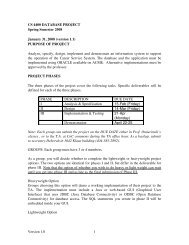
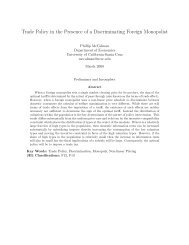


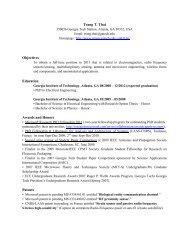

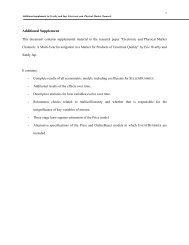

![Resume [pdf] - Prism Web Pages - Georgia Institute of Technology](https://img.yumpu.com/25493251/1/190x245/resume-pdf-prism-web-pages-georgia-institute-of-technology.jpg?quality=85)
